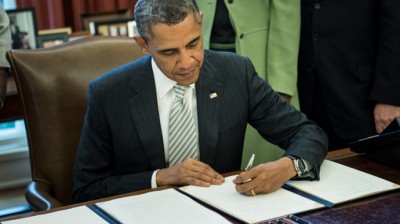 President Obama has signed a climate change executive order that critics say amounts to a dramatic executive branch overreach in authority that could impact property rights and states’ rights.
President Obama has signed a climate change executive order that critics say amounts to a dramatic executive branch overreach in authority that could impact property rights and states’ rights.
The White House says the order will make the process of “streamlining sustainability initiatives” far easier.
Obama signed the executive order in early November, some five months after announcing his new Climate Action Plan, which included climate pollution limits on both new and existing power plants for the very first time. The plan also includes plans to increase renewable energy production on federal land, aid communities in dealing with higher temperatures, and increase energy efficiency standards.
But opponents of the plan say it paved the way for side-stepping Congressional oversight on environmental issues and once again diminished states’ rights. The president’s executive order created a task force to advise his administration on the proper way to respond to wildfires, severe storms, droughts and other natural disasters allegedly brought on by climate change.
President Obama’s task force will also offer guidance on response standards for other “potential impacts” spawned by so-called climate change scenarios. The guiding group created by the executive order included seven Democratic governors and the Republican governor of Guam. Hand-picked mayors from 14 cities and two other local leaders round out the list of climate change advisors. The task force includes California Governor Jerry Brown, Washington Governor Jay Inslee, Hawaii Governor Neil Abercrombie, Delaware Governor Jack Markell, Maryland Governor Martin O’Malley, Vermont Governor Peter Shumlin and Illinois Governor Pat Quinn.
The climate change executive order task force will review how federal money is spent on bridges, roads, flood control projects and other infrastructure programs which President Obama believes are impacted by global warming.
According to a FoxNews report, critics say the task force has the power to:
- “Hold back money to communities unless they meet new standards on various items and agendas set by the Federal Government. For example, using new policies that will encourage communities to rebuild to pre-disaster standards instead of stronger ones.
- Issue a “mandate to bring sweeping new changes to land use and resource policies.
- Control and refocus “climate change data and use of it to push a new agenda into every priority of the Federal Government.
- “Create the need for a new internal organization for coordination efforts during a government sequestration and possible future shutdowns.
A White House release after the climate change executive order was signed stated that even though the country has worked to curb carbon pollution, government officials need to “improve how states and communities” respond to extreme weather events, upgrade building codes, and address climate change impact on infrastructure.
One former senior government official who spoke to Fox News about the climate change executive order said, “The devil is in the details. Who gets to decides what sustainability is? Or what its outcome means?
Others wonder if the plan is part of what is known as Agenda 21. As previously reported by Off The Grid News, Agenda 21 is a voluntary UN non-binding action plan which is supposedly focused solely on sustainable development. It based upon a program to abolish poverty and the “protection of fragile environments” by pushing citizens into metropolitan areas. America is a “signatory” country to Agenda 21. Since the plan is a non-binding statement and not a treaty, a vote on inclusion was not needed. More than 528 major and moderate-sized American cities are members of an international sustainability organization that reportedly supports the implementation of Agenda 21.
A White House release after the climate change executive order was signed stated that even though the country has worked to curb carbon pollution, government officials need to “improve how states and communities” respond to extreme weather events, upgrade building codes, and address climate change impact on infrastructure.











